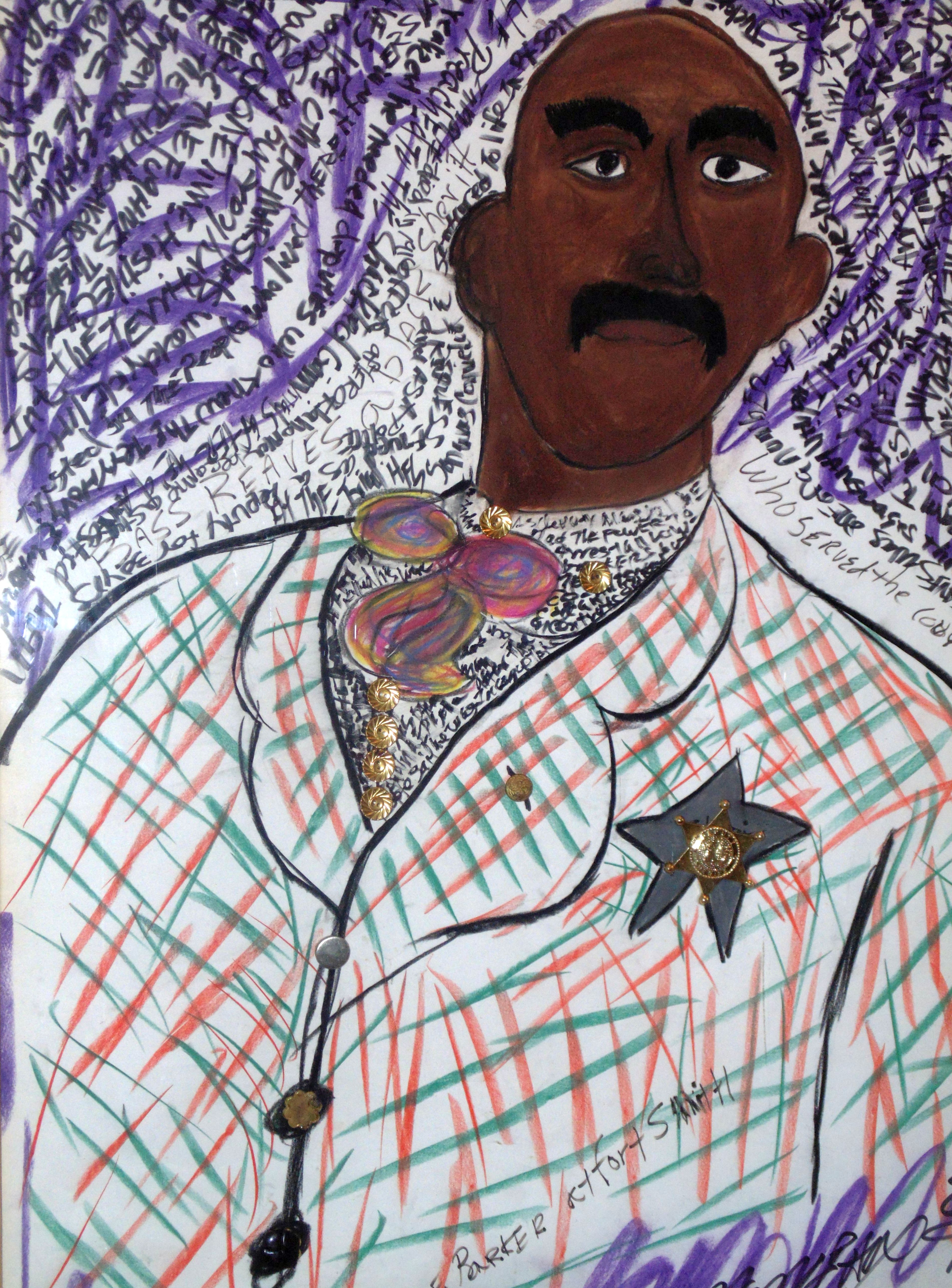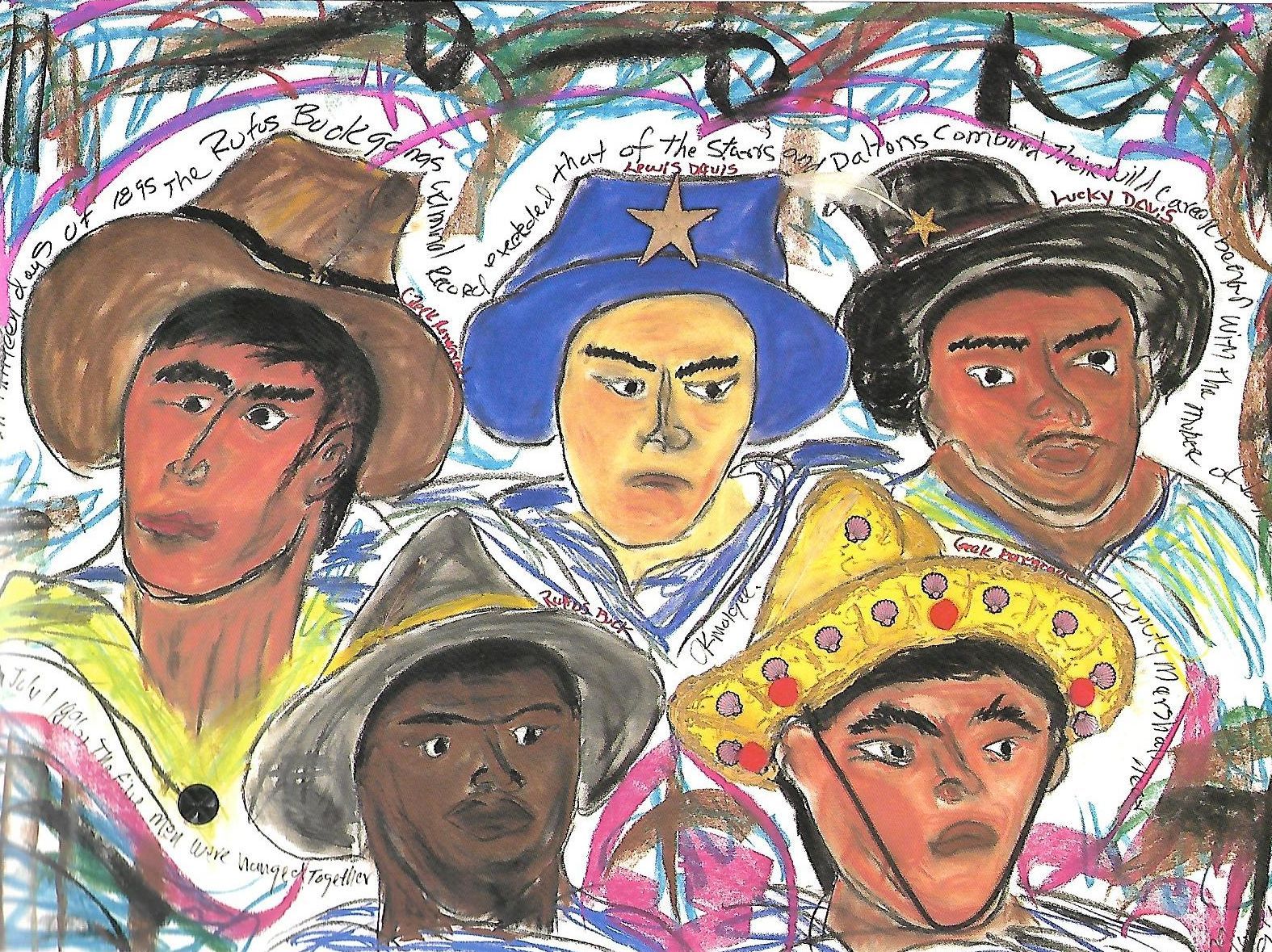About Morgan
Baltimore City

The Great American Storyteller
Born to a wealthy, established Creole family in Louisiana in 1945, I grew up attending segregated schools and attended Bishop College in Dallas, Texas, for three years before doing two tours of duty with the Navy in Vietnam between 1964 and 1973. When I returned home from Navy duty, curiosity as to my standing as a black man and an American citizen drove me to see how the rest of America lived. So, for 17 years thereafter, I… more
Born to a wealthy, established Creole family in Louisiana in 1945, I grew up attending segregated schools and attended Bishop College in Dallas, Texas, for three years before doing two tours of duty with the Navy in Vietnam between 1964 and 1973. When I returned home from Navy duty, curiosity as to my standing as a black man and an American citizen drove me to see how the rest of America lived. So, for 17 years thereafter, I… more
Jump to a project:
Black and Red: African Americans and Native Americans in the West
A Note From Morgan Monceaux
I grew up in Louisiana in a time when it was said that if you had just a drop of Negro blood you were black. I was eight years the summer I learned that I was also part Indian.
All that summer, our relatives kept arriving. I think my great-grandmother Nana knew she was dying, and she called her children and their families to pass along her blessing to them. They came from all over: Shreveport, Louisiana; Michigan; and Oregon. The cousins fit right in with the neighborhood kids, and every night after dinner we’d play cowboys and Indians. My friend Larry insisted on being the sheriff, because he had a badge. “There must be law and order in this black town,” he’d say.
It was my Uncle George who got us thinking about things. The first time I saw him, he was getting off the train in his cowboy boots and a big Mexican hat. He wore a gun belt but no guns. He was very tall and dark, with a big thick mustache, and when he walked he jangled. He smelled of cigars and rose water and sweat. I learned that night that he was Mama’s younger brother. He’d left home when he was thirteen, and had lived in Texas, California, and Mexico, where he owned a ranch.
Uncle George became a hero to us kids that summer. Every night he’d bring out a watermelon and talk to us about Mexico and its people, and about the West. He held us spellbound with his stories about cowboys and Indians, and our games took on a new life.
He started the other grownups talking, too. Mama told us about the Maroon people – fugitive slaves from the West Indies – in Florida. Our great-grandmother told us her mother was from the great Seminole nation that once ruled Florida, and she herself was the daughter of a Creek chief. My cousins and I realized that we had Indian blood in us, too.
One day Papa, my great-grandfather, came out of his workshop to stop a fight between a kid named Renard and my sister Elaine. Renard said there was no such thing as black soldiers in the West. We already knew better, but that day Papa told us about how the buffalo soldiers were called buffalo soldiers because people thought their hair looked like a buffalo’s mane.
Later that summer, Uncle Joe and Uncle George took us kids to Texas to see our first black rodeo. We knew about rodeos, but we had never heard of one where all the cowboys were black. I saw bulldogging for the first time. When we got home, I tried it on my dog Jeff, and he bit me.
That summer helped me see the connection between our games of cowboys and Indians – and the Wild West of the movies – and a history in which my family had a place. It showed me that our heritage included Native Americans, too, and it sparked my lifelong fascination with the West, which I’ve tried to capture in these portraits.
Taken from the book My Heroes, My People by Morgan Monceaux and Ruth Katcher, published by Frances Foster Books in 1999.
I grew up in Louisiana in a time when it was said that if you had just a drop of Negro blood you were black. I was eight years the summer I learned that I was also part Indian.
All that summer, our relatives kept arriving. I think my great-grandmother Nana knew she was dying, and she called her children and their families to pass along her blessing to them. They came from all over: Shreveport, Louisiana; Michigan; and Oregon. The cousins fit right in with the neighborhood kids, and every night after dinner we’d play cowboys and Indians. My friend Larry insisted on being the sheriff, because he had a badge. “There must be law and order in this black town,” he’d say.
It was my Uncle George who got us thinking about things. The first time I saw him, he was getting off the train in his cowboy boots and a big Mexican hat. He wore a gun belt but no guns. He was very tall and dark, with a big thick mustache, and when he walked he jangled. He smelled of cigars and rose water and sweat. I learned that night that he was Mama’s younger brother. He’d left home when he was thirteen, and had lived in Texas, California, and Mexico, where he owned a ranch.
Uncle George became a hero to us kids that summer. Every night he’d bring out a watermelon and talk to us about Mexico and its people, and about the West. He held us spellbound with his stories about cowboys and Indians, and our games took on a new life.
He started the other grownups talking, too. Mama told us about the Maroon people – fugitive slaves from the West Indies – in Florida. Our great-grandmother told us her mother was from the great Seminole nation that once ruled Florida, and she herself was the daughter of a Creek chief. My cousins and I realized that we had Indian blood in us, too.
One day Papa, my great-grandfather, came out of his workshop to stop a fight between a kid named Renard and my sister Elaine. Renard said there was no such thing as black soldiers in the West. We already knew better, but that day Papa told us about how the buffalo soldiers were called buffalo soldiers because people thought their hair looked like a buffalo’s mane.
Later that summer, Uncle Joe and Uncle George took us kids to Texas to see our first black rodeo. We knew about rodeos, but we had never heard of one where all the cowboys were black. I saw bulldogging for the first time. When we got home, I tried it on my dog Jeff, and he bit me.
That summer helped me see the connection between our games of cowboys and Indians – and the Wild West of the movies – and a history in which my family had a place. It showed me that our heritage included Native Americans, too, and it sparked my lifelong fascination with the West, which I’ve tried to capture in these portraits.
Taken from the book My Heroes, My People by Morgan Monceaux and Ruth Katcher, published by Frances Foster Books in 1999.
-
 Bass ReevesA black marshall of whom it was said that he preached to shackled criminals after he arrested them. 40in x 30in. Mixed media on paper with found objects.
Bass ReevesA black marshall of whom it was said that he preached to shackled criminals after he arrested them. 40in x 30in. Mixed media on paper with found objects. -
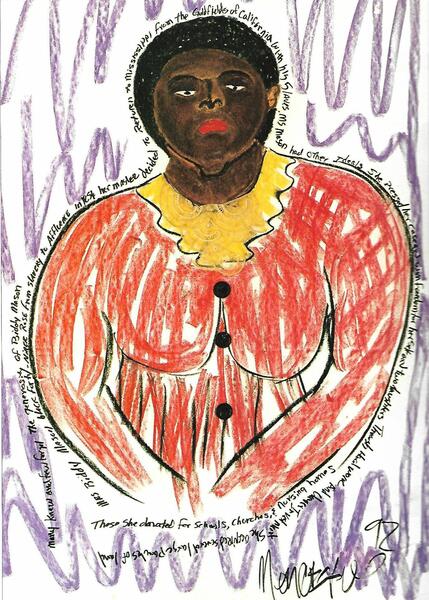 Biddy MasonA slave who became a woman of property. 40in x 30in. Mixed media on paper with found objects.
Biddy MasonA slave who became a woman of property. 40in x 30in. Mixed media on paper with found objects. -
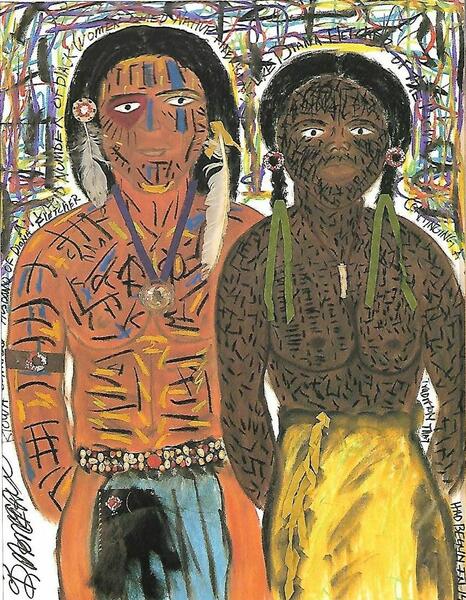 Diana FletcherA black woman who married a Kiowa Indian and lived with the Kiowa. 40in x 30in. Mixed media on paper with found objects.
Diana FletcherA black woman who married a Kiowa Indian and lived with the Kiowa. 40in x 30in. Mixed media on paper with found objects. -
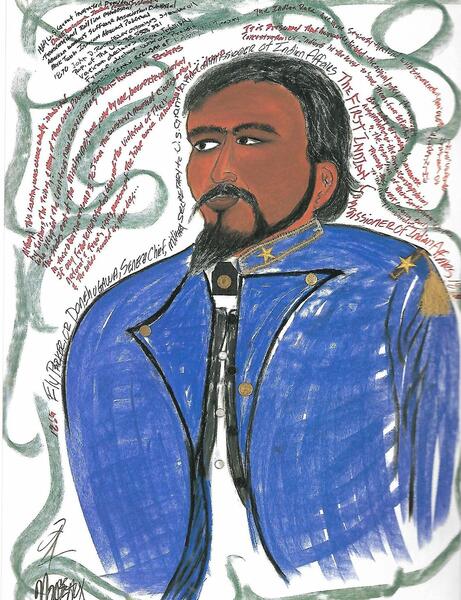 Ely ParkerA lawyer who couldn't argue a case in court because he was an Indian. 40in x 30in. Mixed media on paper with found objects.
Ely ParkerA lawyer who couldn't argue a case in court because he was an Indian. 40in x 30in. Mixed media on paper with found objects. -
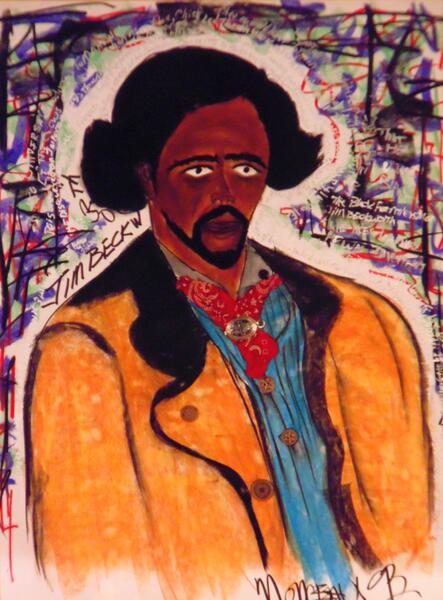 Jim BeckwourthThe slave who became a Crow chief and discovered a passage to the Far West. 40in x 30in. Mixed media on paper with found objects.
Jim BeckwourthThe slave who became a Crow chief and discovered a passage to the Far West. 40in x 30in. Mixed media on paper with found objects. -
 Mary FieldsAlso known as "Stagecoach Mary", she was a mail carrier who also ran a restaurant. 40in x 30in. Mixed media on paper with found objects.
Mary FieldsAlso known as "Stagecoach Mary", she was a mail carrier who also ran a restaurant. 40in x 30in. Mixed media on paper with found objects. -
 Nat Love"I was wild, reckless, and free, and afraid of nothing" 40in x 30in. Mixed media on paper with found objects
Nat Love"I was wild, reckless, and free, and afraid of nothing" 40in x 30in. Mixed media on paper with found objects -
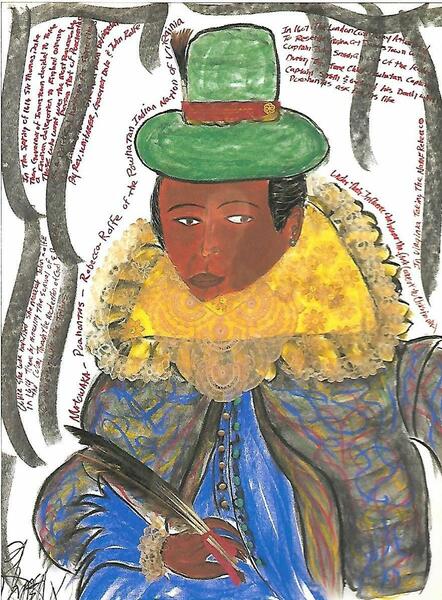 PocahontasThe Indian princess who became an English lady. This particular work was cited in Heike Paul's "The Myths That Made America" (published by [transcript], Germany, in 2014). 40in x 30in. Mixed media on paper with found objects.
PocahontasThe Indian princess who became an English lady. This particular work was cited in Heike Paul's "The Myths That Made America" (published by [transcript], Germany, in 2014). 40in x 30in. Mixed media on paper with found objects. -
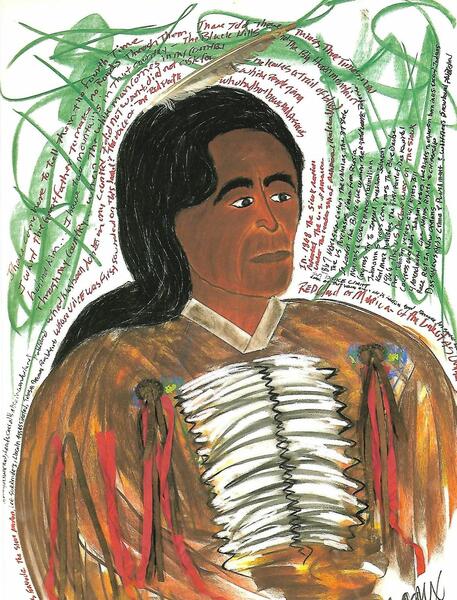 Red Cloud"The white children have surrounded me and left me nothing but an island" 40in x 30in. Mixed media on paper with found objects.
Red Cloud"The white children have surrounded me and left me nothing but an island" 40in x 30in. Mixed media on paper with found objects. -
 The Rufus Buck GangTrue outlaws. 30in x 40in. Mixed media on paper with found objects.
The Rufus Buck GangTrue outlaws. 30in x 40in. Mixed media on paper with found objects.
The Cost of Not Preventing Crack Babies
This is an installation performance piece incorporating headless baby dolls, entitled "The Cost of Not Preventing Crack Babies".
This exhibition and performance is based on the universal theme of human frailty, tragedy and suffering - art reflects life. You, the viewer, as participants, are challenged to respond, to be alive and to value humankind.
My intention was to draw attention to the problem of crack addiction and to highlight where the responsibility lies.
This piece was first performed at Artscape 2003 in Baltimore. The format was that of a funeral, complete with readings, personal testimonials and a final procession. Included within the space were headless baby dolls, drug paraphernalia and a coffin.
Originally recorded on VHS.
This exhibition and performance is based on the universal theme of human frailty, tragedy and suffering - art reflects life. You, the viewer, as participants, are challenged to respond, to be alive and to value humankind.
My intention was to draw attention to the problem of crack addiction and to highlight where the responsibility lies.
This piece was first performed at Artscape 2003 in Baltimore. The format was that of a funeral, complete with readings, personal testimonials and a final procession. Included within the space were headless baby dolls, drug paraphernalia and a coffin.
Originally recorded on VHS.
-
Crack BabiesThis is an installation performance piece incorporating headless baby dolls, entitled "The Cost of Not Preventing Crack Babies".
-
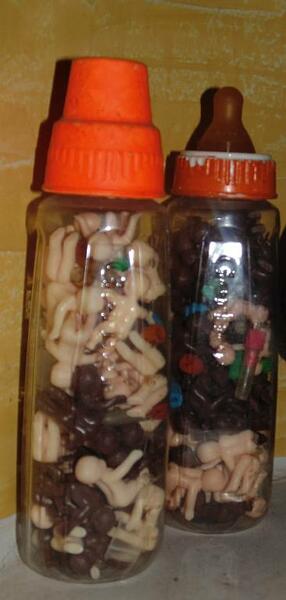 Baby's Feeding BottleBaby's feeding bottle containing found objects
Baby's Feeding BottleBaby's feeding bottle containing found objects -
 Dark Headless DollHeadless doll
Dark Headless DollHeadless doll -
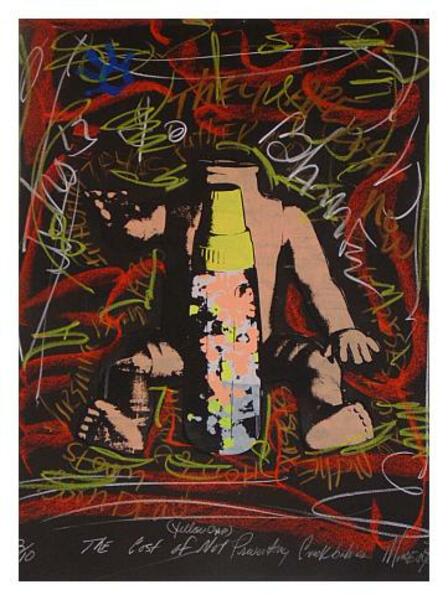 Crack Babies Silkscreen Print40in x 30in. Silkscreen print.
Crack Babies Silkscreen Print40in x 30in. Silkscreen print. -
crack_babies1.mp3This is an excerpt from an hour-long CD that accompanies the Crack Babies installation performance piece. The title is "Crack Attack" by Grace Jones which comes from the 1989 album "Bulletproof Heart" on the Capitol label.
